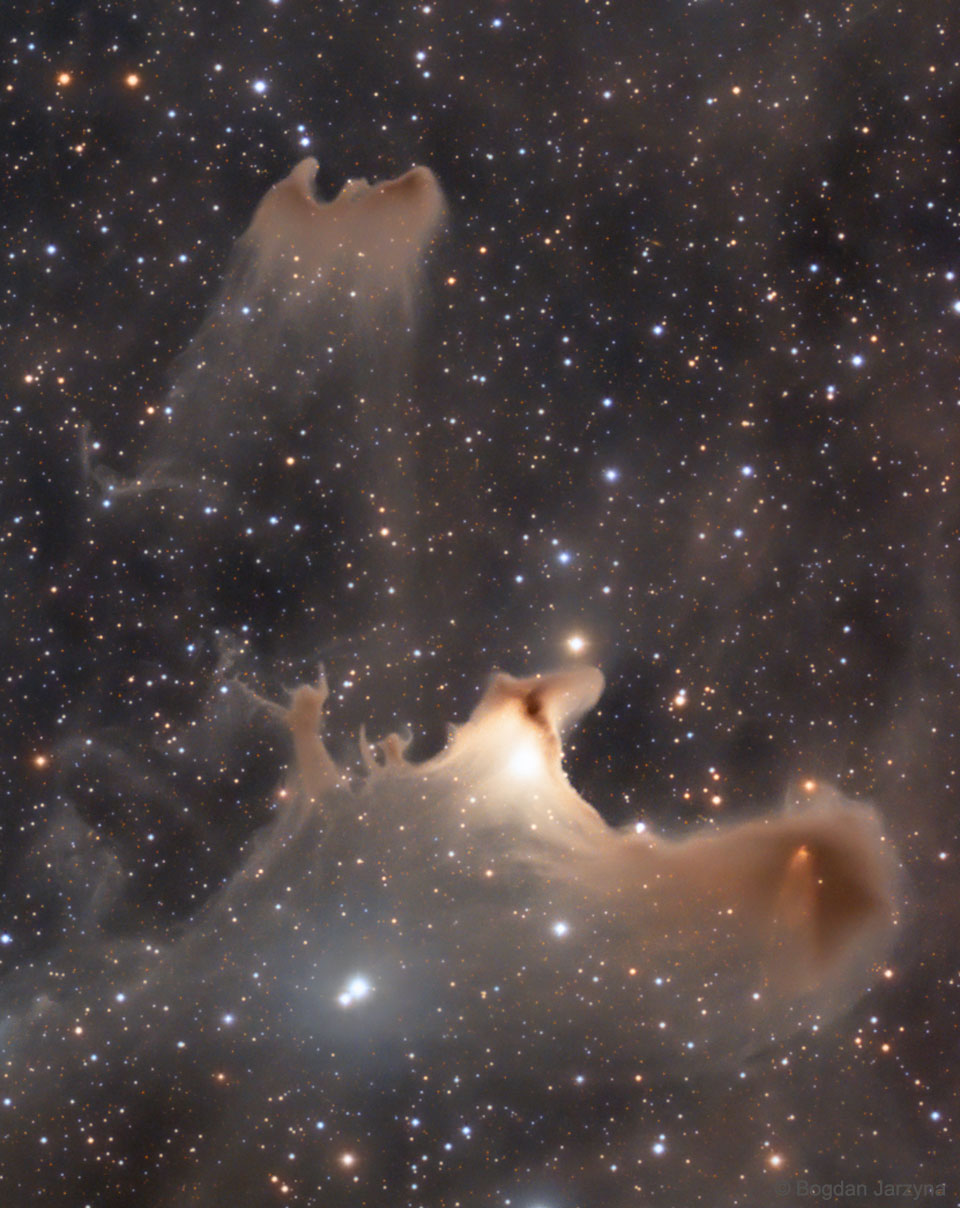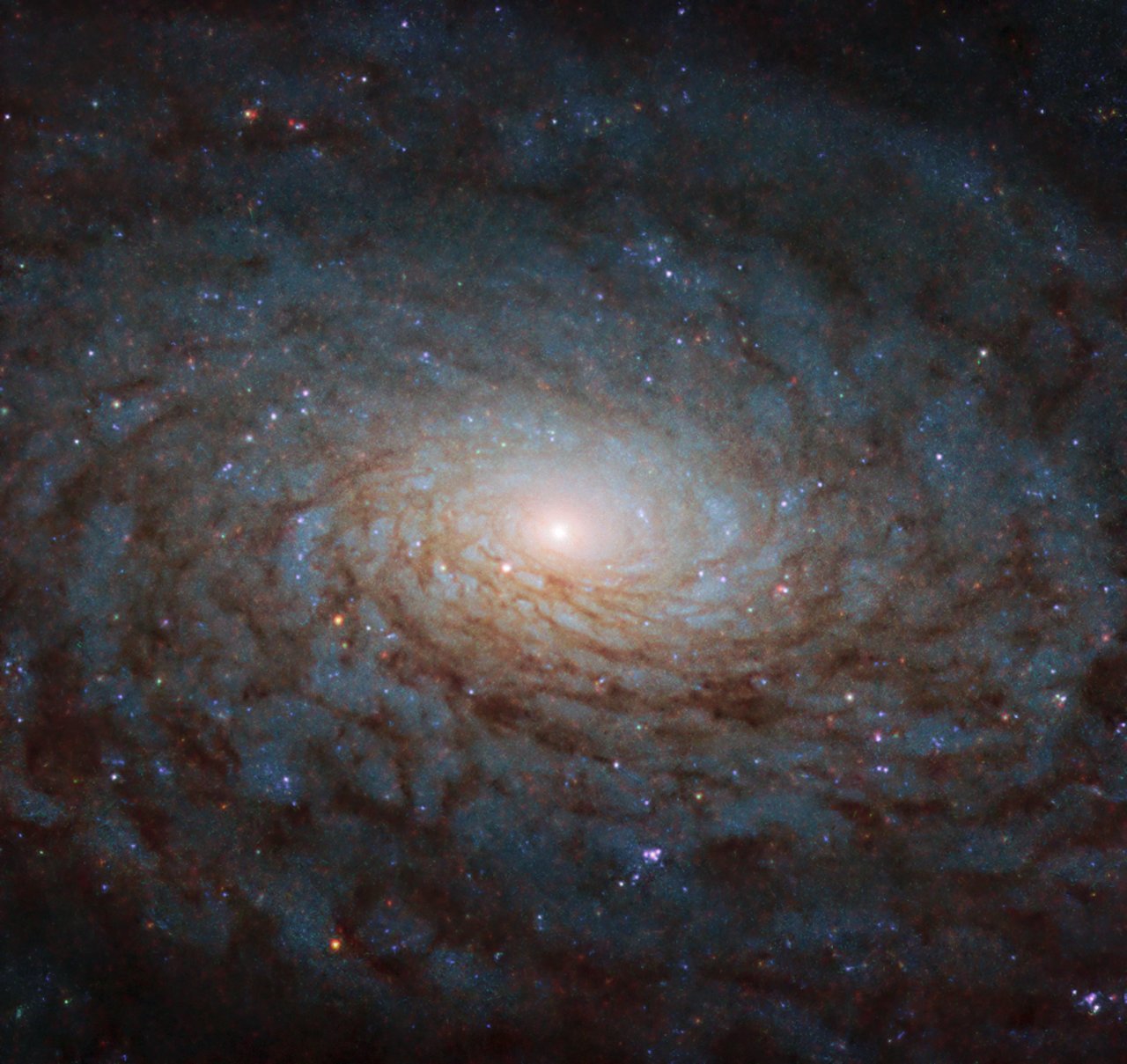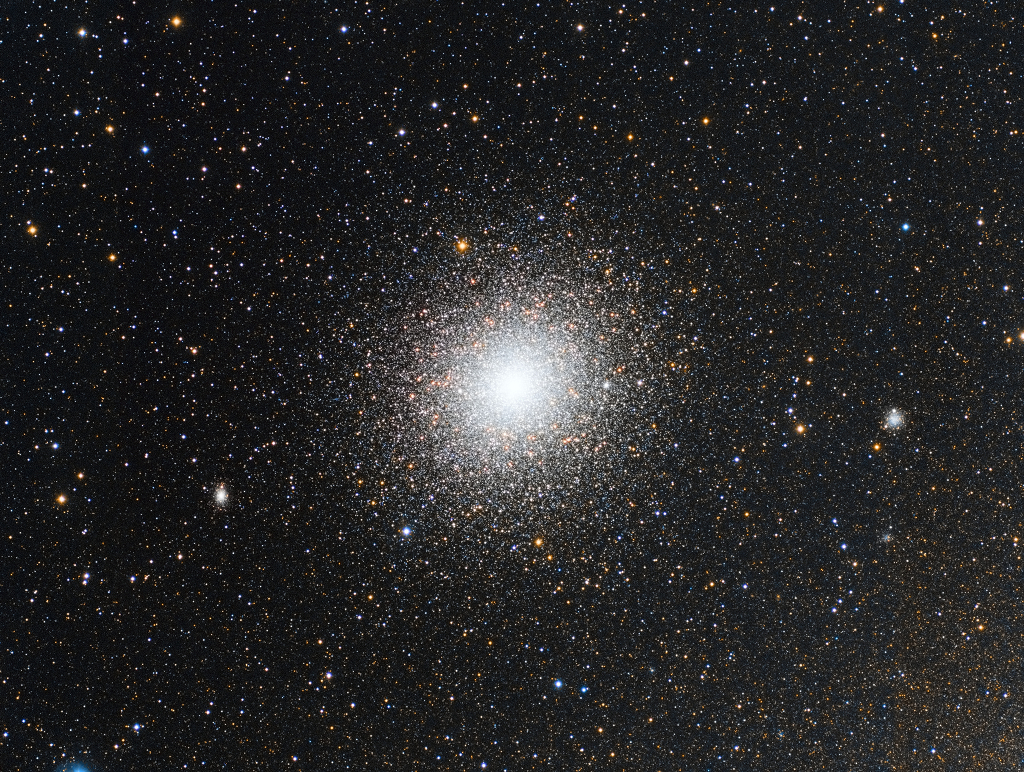Blog
The jeweled expanse, filled with faint, starlight-reflecting clouds, drifts through the night in the royal constellation of Cepheus. Far from your own neighborhood on planet Earth, these ghostly apparitions lurk along the plane of the Milky Way at the edge of the Cepheus Flare molecular cloud complex some 1,200 light-years away. Over two light-years across and brighter than the other spooky chimeras, VdB 141 or Sh2-136 is also known as the Ghost Nebula, seen at toward the bottom of the featured image. Within the reflection nebula are the telltale signs of dense cores collapsing in the early stages of star formation.

William Earl “Bootsy” Collins (born October 26, 1951) is an American musician, singer and songwriter.
Rising to prominence with James Brown in the early 1970s, and later with Parliament-Funkadelic, Collins’s driving bass guitar and humorous vocals established him as one of the leading names in funk. He is a member of the Rock and Roll Hall of Fame, inducted in 1997 with 15 other members of Parliament-Funkadelic. Collins was born in Cincinnati, Ohio, United States, on October 26, 1951. He said that his mother named him “Bootsy”. “I asked her why,” he explained to a journalist, “and she just said, ‘Because you looked like a Bootsy.’ I left it at that.”
His brother Phelps “Catfish” Collins (1943–2010) was also a musician. He and Bootsy were once part of James Brown’s backing band, The Pacemakers.
more...Milton Nascimento (Portuguese pronunciation: [‘miwtõ nasiˈmẽtu]; born October 26, 1942) is a prominent Brazilian singer-songwriter and guitarist.
Milton Nascimento was born in Rio de Janeiro. His mother, Maria Nascimento, was a maid. As a baby, Nascimento was adopted by a couple who were his mother’s former employers; Josino Brito Campos, a bank employee, mathematics teacher and electronic technician and Lília Silva Campos, a music teacher and choir singer. When he was 18 months old, Nascimento’s biological mother died, and he moved with his adoptive parents to the city of Três Pontas, in the state of Minas Gerais.
Nascimento was an occasional DJ on a radio station that his father once ran. He lived in the boroughs of Laranjeiras and Tijuca in Rio de Janeiro.
In the early stages of his career, Nascimento played in two samba groups, Evolussamba and Sambacana. In 1963, he moved to Belo Horizonte, where his friendship with Lô Borges led to the Clube da Esquina (“street corner club”) movement. Members included Beto Guedes, Toninho Horta, Wagner Tiso, and Flávio Venturini, with whom he shared compositions and melodies. One composition was “Canção do Sal”, which was first interpreted by singer Elis Regina in 1966 and led to a television appearance with Nascimento. The collective, as well as some others, released Clube da Esquina in 1972. Several hit singles were also released.
https://www.youtube.com/watch?v=kZNdbBYLliE
more...Edward Jackson Henderson (born October 26, 1940) is an American jazz trumpet and flugelhorn player. He came to prominence in the early 1970s as a member of pianist Herbie Hancock‘s band, going on to lead his own electric/fusion groups through the decade. Henderson earned his medical degree and worked a parallel career as a psychiatrist and musician, turning back to acoustic jazz by the 1990s.
Henderson’s influences include Booker Little, Clifford Brown, Woody Shaw, and Miles Davis.
Henderson’s mother was one of the dancers in the original Cotton Club. She had a twin sister, and they were called The Brown Twins. They would dance with Bill “Bojangles” Robinson and the Nicholas Brothers. In the film showing Fats Waller playing “Ain’t Misbehavin'”, Henderson’s mother sat on the piano whilst Waller sang to her. His father sang with Billy Williams and The Charioteers, a popular singing group.
more...Warne Marion Marsh (October 26, 1927 – December 18, 1987) was an American tenor saxophonist. Born in Los Angeles, his playing first came to prominence in the 1950s as a protégé of pianist Lennie Tristano and earned attention in the 1970s as a member of Supersax.
Marsh came from an affluent artistic background: his father was Hollywood cinematographer Oliver T. Marsh (1892–1941), and his mother Elizabeth was a violinist. He was the nephew of actresses Mae Marsh and Marguerite Marsh and film editor Frances Marsh.
He was tutored by Lennie Tristano. Marsh was often recorded in the company of other Cool School musicians, and remained one of the most faithful to the Tristano philosophy of improvisation – the faith in the purity of the long line, the avoidance of licks and emotional chain-pulling, the concentration on endlessly mining the same small body of jazz standards. While Marsh was a generally cool-toned player, the critic Scott Yanow notes that Marsh played with “more fire than one would expect” in certain contexts.
more...The galaxy NGC 4380 looks like a special effect straight out of a science fiction or fantasy film in this Hubble Picture of the Week, swirling like a gaping portal to another dimension.
In the grand scheme of things, though, the galaxy is actually quite ordinary. Spiral galaxies like NGC 4380 are one of the most common types of galaxy in the Universe. These colossal collections of stars, often numbering in the hundreds of billions, are shaped like a flat disc, sometimes with a rounded bulge in the centre. Graceful spiral arms outlined by dark lanes of dust wind around the bulging core, which glows brightly and has the highest concentration of stars in the galaxy.

James Edward Heath (October 25, 1926 – January 19, 2020), nicknamed Little Bird, was an American jazz saxophonist, composer, arranger, and big band leader. He was the brother of bassist Percy Heath and drummer Albert Heath.
Heath was born in Philadelphia on October 25, 1926. His father, an auto mechanic, played the clarinet, performing on the weekends. His mother sang in a church choir. The family frequently played recordings of big band jazz groups around the house. Heath’s sister was a pianist, while his brothers were bassist Percy Heath (older) and drummer Albert Heath (his youngest sibling).
During World War II, Heath was rejected for the draft for being below the minimum weight.
Heath originally played alto saxophone. He earned the nickname “Little Bird” after his work for Howard McGhee and Dizzy Gillespie in the late 1940s, during which his playing displayed influences from Charlie Parker (Parker’s nickname was “Bird”). He then switched to tenor saxophone.
From late 1945 through most of 1946, he performed with the Nat Towles band. In 1946, he formed his own band, which was a fixture on the Philadelphia jazz scene until 1949. The band included John Coltrane, Benny Golson, Specs Wright, Cal Massey, Johnny Coles, Ray Bryant, and Nelson Boyd. Charlie Parker and Max Roach sat in on one occasion. The band performed at venues such as the Apollo Theater in Harlem. Although Heath recalls that the band recorded a few demos on acetate, it never released any recordings, and its arrangements were lost at a Chicago train station. The band dissolved in 1949 so that Heath could join Dizzy Gillespie’s band.
more...Eddie Lang (born Salvatore Massaro, October 25, 1902 – March 26, 1933) is known as the father of jazz guitar. During the 1920s, he gave the guitar a prominence it previously lacked as a solo instrument, as part of a band or orchestra, and as accompaniment for vocalists. He recorded duets with guitarists Lonnie Johnson and Carl Kress and jazz violinist Joe Venuti, and played rhythm guitar in the big band of Paul Whiteman and was the favoured accompanist of Bing Crosby.
The son of an Italian-American instrument maker, Lang was born in Philadelphia, Pennsylvania, and grew up with violinist Joe Venuti. His first instrument was violin when he was seven. He performed on violin in 1917 and became a member of a trio. In 1920, he dropped the violin for banjo and worked with Charlie Kerr, then Bert Estlow, Vic D’Ippolito, and Billy Lustig‘s Scranton Siren Orchestra. A few years later, he dropped the banjo for guitar when he became a member of the Mound City Blue Blowers led by Red McKenzie. He recorded one of the first solos in 1924 on “Deep 2nd Street Blues”. His performances with McKenzie’s band drew attention, and he found many jobs as a freelance guitarist. Before Lang, the guitar hadn’t been a prominent instrument in jazz bands and dance orchestras.
more...Georges Bizet (25 October 1838 – 3 June 1875), registered at birth as Alexandre César Léopold Bizet, was a French composer of the Romantic era. Best known for his operas in a career cut short by his early death, Bizet achieved few successes before his final work, Carmen, which has become one of the most popular and frequently performed works in the entire opera repertoire.
During a brilliant student career at the Conservatoire de Paris, Bizet won many prizes, including the prestigious Prix de Rome in 1857. He was recognised as an outstanding pianist, though he chose not to capitalise on this skill and rarely performed in public. Returning to Paris after almost three years in Italy, he found that the main Parisian opera theatres preferred the established classical repertoire to the works of newcomers. His keyboard and orchestral compositions were likewise largely ignored; as a result, his career stalled, and he earned his living mainly by arranging and transcribing the music of others. Restless for success, he began many theatrical projects during the 1860s, most of which were abandoned. Neither of his two operas that reached the stage in this time—Les pêcheurs de perles and La jolie fille de Perth—were immediately successful.
After the Franco-Prussian War of 1870–1871, during which Bizet served in the National Guard, he had little success with his one-act opera Djamileh, though an orchestral suite derived from his incidental music to Alphonse Daudet‘s play L’Arlésienne was instantly popular. The production of Bizet’s final opera, Carmen, was delayed because of fears that its themes of betrayal and murder would offend audiences. After its premiere on 3 March 1875, Bizet was convinced that the work was a failure; he died of a heart attack three months later, unaware that it would prove a spectacular and enduring success.
Bizet’s marriage to Geneviève Halévy was intermittently happy and produced one son. After his death, his work, apart from Carmen, was generally neglected. Manuscripts were given away or lost, and published versions of his works were frequently revised and adapted by other hands. He founded no school and had no obvious disciples or successors. After years of neglect, his works began to be performed more frequently in the 20th century. Later commentators have acclaimed him as a composer of brilliance and originality whose premature death was a significant loss to French musical theatre.
more...https://www.youtube.com/watch?v=OJKe2j9Wjh4
more...Globular star cluster 47 Tucanae is a jewel of the southern sky. Also known as NGC 104, it roams the halo of our Milky Way Galaxy along with some 200 other globular star clusters. The second brightest globular cluster (after Omega Centauri) as seen from planet Earth, it lies about 13,000 light-years away and can be spotted naked-eye close on the sky to the Small Magellanic Cloud in the constellation of the Toucan. The dense cluster is made up of hundreds of thousands of stars in a volume only about 120 light-years across. Red giant stars on the outskirts of the cluster are easy to pick out as yellowish stars in this sharp telescopic portrait. Tightly packed globular cluster 47 Tuc is also home to a star with the closest known orbit around a black hole.

Bill Wyman (born William George Perks; 24 October 1936) is an English musician, record producer, songwriter and singer. He was the bassist for the English rock and roll band the Rolling Stones from 1962 until 1993. Since 1997 he has recorded and toured with his own band, Bill Wyman’s Rhythm Kings. He has worked producing records and films, and has scored music for films and television.
Wyman has kept a journal since he was a child after World War II. He has published seven books. Wyman is also a photographer, and his works have been displayed in galleries around the world. He became an amateur archaeologist and enjoys metal detecting. He designed and marketed a patented “Bill Wyman signature metal detector“, which he has used to find relics in the English countryside dating back to the era of the Roman Empire.
more...More Posts
- Aretha Franklin
- Paul Motian
- Cecil Taylor
- World Music Kyenkyen Bi Adi M’awu
- Daily Roots Rupie Edwards
- Echos of Freedom H.P. Lovecraft
- Cosmo NGC 5530
- Lee Oskar
- Paul McCandless
- Boogie Bill Webb
- Carol Kaye
- Georg Philipp Telemann
- Steve Kuhn
- World Music Elana Sasson · Matthieu Saglio
- Daily Roots Cornell Campbell
- Cosmo Vela SNR
- Chaka Khan
- David Grisman
- Robert Cage
- Louisiana Red